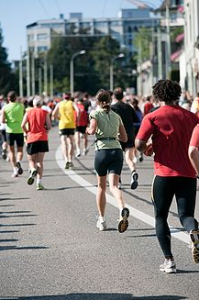The human body is truly a marvelous thing. Have you ever wondered how we actually get the energy to run?
ATP (adenosine triphosphate) is the energy-rich source for muscle action. It is formed in the muscle fibers by small bodies called mitochondria and is made in various different ways. Fats in muscle tissue (adipose tissue) are broken down to become free fatty acids in the muscle and also in the blood. Ultimately, in the muscle fibers they are oxidized to deliver energy to make ATP. Glucose from the blood is also oxidized in the muscle fibers to form ATP. Some glucose from the blood is stored in the muscles as carbohydrates, called glycogen. Then, as ATP is needed, this glycogen is broken down into glucose, which, without the use of oxygen, produces ATP.
These methods for making ATP are used simultaneously, but in varying degrees, according to the circumstances. The kind of exercise, its intensity, its duration, the physical fitness of the individual—all are factors governing how much ATP each method will supply at given times. Relative to distance running, however, when the exercise has been intense for a long time, the mainstay for ATP production is glycogen.
Marathoners often do what is called carbohydrate-loading. A few days before a race they gorge on carbohydrates, and in so doing they can maximize and top up the amount of glycogen stored in their muscles by as much as 300 percent. A by-product of this use of glycogen, however, is lactic acid, and it is its accumulation in the muscles that causes fatigue, and eventually muscle soreness.

So our bodies mainly use carbohydrates and fats to give us energy while we are running. The more in shape you are the better your body will become at converting fat into energy. The more energy you have the longer you will be able to run and your stamina will be increased.
